Viva! Art Action
in Montreal, Canada
3rd Oct. 2006
at Bain St-Michel
ARAI Shin-ichi(Japan)
"Viva! United States -for Herbert Norman"
ARAI said
I like Canada very much since my childhood, because I had maple reef pin badge.
In 1969 Canadian people visited my primal school to introduce Canada and the pavilion of Canada in EXPO 1970 in Osaka, Japan.
Those days I lived in small town very far from both Tokyo and Osaka.
And they gave us small maple pin badges. It was my real treasure.
Then in the university I studied modern history of Japan.
I knew Canadian historian, Herbert Norman who studied modern history of Japan.
And his point of view on modern history of Japan is very important especially on democracy tradition before World War Second in Japan. Many Japanese historians think before World War Second there was no democracy tradition in Japan.
He was born to Methodist missionary parents in Japan 1909, Norman was educated in Japan and Canada before moving on to studies at Cambridge and Harvard.
He returned to Tokyo at the end of the war to work under General Douglas Macarthur and served as head of the Canadian Liaison Mission until 1950.
Things began to fall apart for Norman in 1959 when questions were raised in a US Senate committee about his reliability and his past activities at Cambridge in UK.
In student days at Cambridge, Norman had been a close sympathizer and supporter of the Communist Party.
In 1956 he was moved to Cairo as Canadian Ambassador to Egypt where, with the outbreak of the Suez Crisis, he found himself in the international spotlights once again.
Norman established a close relationship with Egyptian President Nasser and played a helpful role in defusing the crisis, but his presence in Cairo sparked criticism in Washington that someone of Normanfs questionable security background would occupy such a sensitive position.
He was named again in the Senate Internal Security Subcommitte in mid-March 1957.
In desperation and fear of second round of questioning, Norman took his on life by jumping off the roof of a hotel in Cairo on 4 April 1957.
ARAI nailed into the portrait of Herbert Noman and his wife.
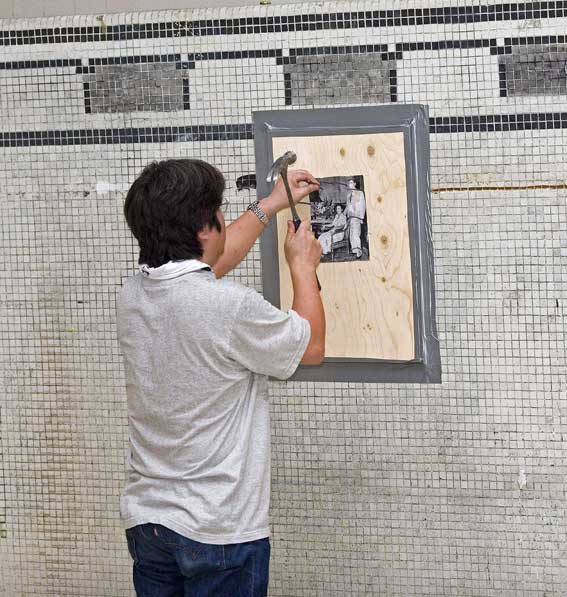
ARAI said
In our primal school days (almost 40 years before) in Japan
We had school lunch with breads and powdered skimmed milk and some dishes.
And I had eaten neither bread nor milk at my home. We ate rice and miso
soup there. The bread was made by expired flour in USA as well as the powdered skimmed milk which are the food of livestock in United states. United states gov't
sold them to Japan gov't. So we were familiar with bread and milk. Sometimes
I asked my mother to buy bread and milk. But She said that they were too
expensive to buy for us.
ARAI dreged portrait of Norman and his wife with powdered skimmed milk
and flour
ARAI asked audience to dredge over him with powdered skimmed milk and flour.
And asked them to massage softly him with the items.
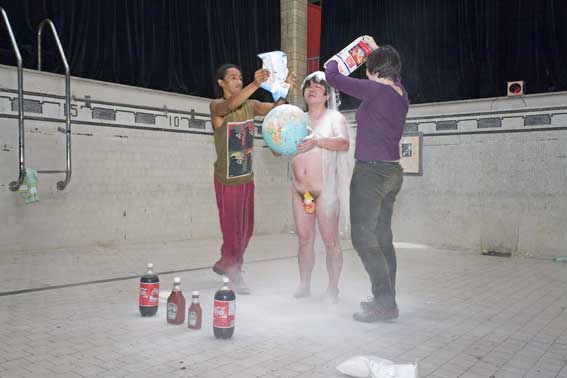
ARAI shouted "Viva! United States , Viva! expired flour, Viva! expired
powder milk"
Also I liked Coca-cola very much but I only could get it once or twice for the year. When our relatives visited us at new year or some festival, they gave me small money and I ran to buy Coca-cola. My parents asked me why I like Coca-cola taste like medicines and it is very expensive!
ARAI dreged portrait of Norman and his wife with Coca-cola
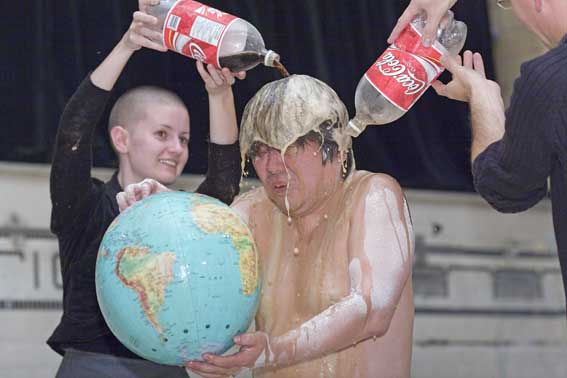
That day in TV spots every day sung "DEL MONTE tomato ketchup" song. So we children happily sung "DEL MONTE tomato ketchup"
song without knowing wha is the ketchup. After I liked ketchup very much
so every foods I used ketchup. But my parents never used it.
ARAI sung the "DEL MONTE tomato ketchup" song.
ARAI dreged portrait of Norman and his wife with tomato ketchap
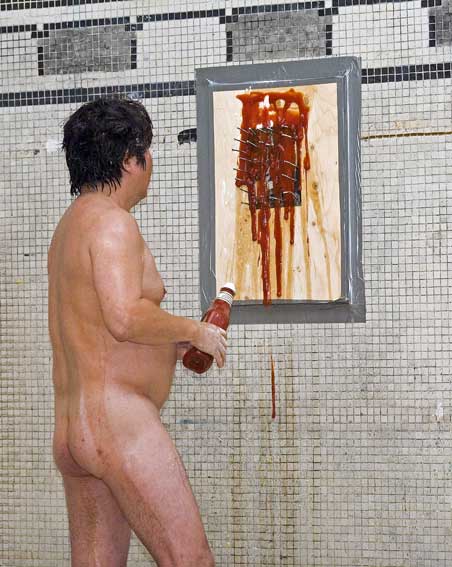

There was Ajinomoto, monosodium glutamate as chemical flavor enhancer, on the kitchen table for cooking. Usually
my family drag it almost all dishes.
And Ajiomoto was said that makes people clever especialy for children.
ARAI dreged portrait of Norman and his wife with monosodium glutamate.
*Ajinomoto is Japanese company of monosodium glutamate which company enveted
and made monosodium glutamate in 1909.
Ajinomoto means " King of flavor" in Japanese.
Now especially in Asia countries there are many companies like Ajinomo.
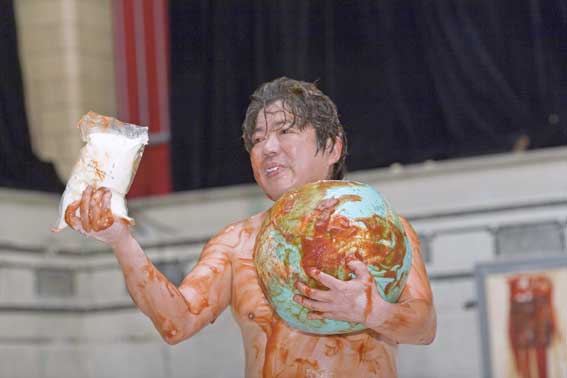
My home town is very country side so 40 years before around my house were
almost all rice field and some petolol station. But nowadays there are
no rice fields but are McDonald's,Kentucky Fried Chicken, 24 hr open convenience store like "Seven-Eleven", and USA style road side restaurant.
Also our Japanese kitchen there are no Ajinomoto now. but all food we buy from store exactly contain it already.
My father who died 3 years ago liked Kentucky Fried Chicken very much in his last years.
He also liked Japanese sake very much and drunk sake and ate Kentucky Fried Chicken.
He drunk sake with Kentucky Fried Chicken.
Now my mother lives alone in my home town. She told me that she sometimes
dose not like to make her meal so she buy breads and milk at convenience
store "Seven-Eleven" for her lonely dinner.
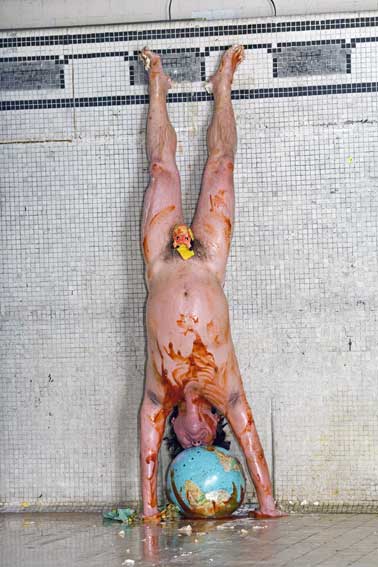
ARAI shouted "Viva! United States" again and again.
ARAI Shin-ichi(Japan)
"Viva! United States -for Herbert Norman"
Photos ; Guy L'Heureux
More about Herbert Norman from "The Red Scare 1949- 1957" wriiten by David MacKenzie
THE HERBERT NORMAN CASE
Few individuals experienced the worst aspects of the Red Scare more than Herbert Norman, the academic turned public servant who was hounded by accusations and rumours of disloyalty until 1957 when, unable to face another round of witch hunting, he took his own life by jumping off the roof of a hotel in Cairo. Born to Methodist missionary parents in Japan in 1909, Norman was educated in Japan and Canada before moving on to studies at Cambridge and Harvard. He began a career as an academic, publishing many articles and books, including The Emergence of Modern Japan (1940) which established his reputation as a scholar. Norman joined the Department of External Affairs in 1939 and, thanks to his knowledge of Japan and his fluency in Japanese, he served in Tokyo and, after 1942, in Ottawa directing signals intelligence against the Japanese. He returned to Tokyo at the end of the war to work under General Douglas MacArthur and served as head of the Canadian Liaison Mission until 1950.
Things began to fall apart for Norman in 1950 when questions were raised
in a US Senate committee about his reliability and his past activities
at Cambridge. In his student days at Cambridge. Norman had been a close
sympathizer and supporter of the Communist Party. but had not been checked
in 1939 and he was out of the country after 1946 when the first round of
security screenings began, although the FBI had already opened a file on
him a few years earlier. With the outbreak of McCarthyism in the United
States, it was almost inevitable that his name would come up during the
meetings of the Senate Internal Security Subcommittee. Norman was brought
back to Ottawa on 16 October 1950 from his posting in Tokyo and interviewed
over a six-week period by the RCMP and members of the Department of External
Affairs. He was cleared on all counts (even though, of course, he had not
been charged with any crime). External Affairs Minister Lester Pearson
supported Norman at the time and indeed, stood behind him throughout this
ordeal and for the rest of his life.
Following the investigation. Norman was placed in less central positions;
from 1951-53 he headed the Department's Information Division, and from
1953-56 he served as Canada's High Commissioner to New Zealand. In 1956
he was moved to Cairo as Ambassador to Egypt where, with the outbreak of
the Suez Crisis, he found himself in the international spotlight once again.
Norman established a close relationship with Egyptian President Nasser
and played a helpful role in defusing the crisis, but his presence in Cairo
sparked criticism in Washington that someone of Norman's questionable security
background would occupy such a sensitive position. He was named again in
the Senate Internal Security Subcommittee in mid-March 1957. In desperation
and fear of a second round of questioning. Norman took his own life on
4 April 1957.
Even in death, however, the debate over Herbert Norman continued. On one
side were those who believed that Norman was hounded to death by an American
witch hunt. These individuals believed he could not face another inquisition
into his record and was concerned that it might involve his supporters,
including Lester Pearson. On the other side were those who believed that
Norman was a security risk and that he chose suicide because the charges
against him were true. These individuals argued that he feared exposure,
not only of himself but of others. perhaps including Pearson, if all the
facts came out.
The whole affair was re-opened in the mid-1980s following the publication
of No Sense of Evil , a blatant and unequivocal attack on Norman by the late James Barros,
a former political scientist at the University of Toronto. Barros never
let the reasonable use of evidence get in the way of his accusations, and
he presented the case that Norman, if not a KGB spy, was at least an "agent
of influence" for the Soviet Union. In 1989, thanks to the backing
of two Conservative Members of Parliament who came to support Barros' theories,
Joe Clark, then Secretary of State for External Affairs in the Mulroney
government, commissioned Ottawa political scientist and former diplomat
Peylon Lyon to investigate Norman's allegiance and the charges of espionage
against him. Lyon was given access to the relevant files in the Department
of External Affairs, the RCMP, and the Department of National Defence,
and he also acquired Norman's FBI file. In his 1990 report, Lyon argued
that after all of his investigations (and not to mention the investigative
work of various other scholars and the revelations of former spies and
agents who have gone public in the intervening forty years) no evidence
could be found that Norman was a spy or even an "agent of influence"
for the Soviet Union or the Communist Party of any country. The Mulroney
government accepted Lyon's conclusions and declared the case closed. But
even today echoes of the debate can still be heard as Canadians continue
to wrestle with the facts - and the meaning - of the life and death of
Herbert Norman.
CONCLUSION
The death of Herbert Norman sparked an outpouring of anger and anti-Americanism across Canada. Many held the Americans responsible@for Norman's death, and the whole@affair seemed to expose the excesses and paranoia of the American obsession over internal security. For some Canadians it raised a few doubts about American leadership in the Cold War and led them to re-examine Canada's relationship with the United States. But it did not bring about any substantial change in Canada's Cold@War policy or in the close Canadian-American defence alliance.
Norman's death was a turning point in the Red Scare which for most Canadians, witch hunting was exposed for what it was: a rather ugly form of persecution. In this way, Norman's death can be seen as the symbolic end of the Red Scare in Canada. By 1957 the impact of the Gouzenko affair declined, while in the United States McCarthy and his Senate investigations had been outflanked@by the Republican Eisenhower administration. The Cold War had become commonplace and a calmer, more rational atmosphere had replaced the initial wave of anxiety and unrest. Canadians were learning to live with the bomb.
Norman's death did not, however, end state security screening and surveillance of government workers, nor did it mark the end of the government's concern for internal security, nor did it put an end to anti-communist ratings or blacklisting - all these things would continue throughout the Cold War. The RCMP maintained its search for "subversives" - usually in all the wrong places - and even found new targets among Quebec separatists and the Canadian New left. But by the early 1960s the government's security machinery was functioning more smoothly and there were fewer public mishaps to cause alarm or lead to any kind of public scrutiny, as had been the case with the National Film Board.
("The Red Scare 1949- 1957" p20-23)
On the life and tragic death of Herbert Norman, see
Roger Bowen, Innocence Is Not Enough: The Life and Death of Herbert Norman (Vancouver, 1986); and Bowen, ed., E.H. Norman: His Llfe and Scholarship (Toronto, 1984). The case for the opposition is made by James Barros in No Sense of Evil: Espionage, The Case of Herbert Norman (Toronto, 1986). Peyion Lyon's commissioned report can found in "The Loyalties of E. Herbert Norman " Labour/Le Travail 28 (Fall 1991) p.219-259. On Pearson's involvement, see John English's two
volume The Llfe of Lester Pearson (Toronto, 1989 and 1992).
David MacKenzie was born in Montreal and educated at McGill University (BA) and the University of Toronto (MA and PhD). He is the author of many books and articles on Canadian history and international relations, including: Inside the Atlantic Triangle: Canada and the Entrance of Newfoundland into Confederation. 1939-1949 (Toronto, UTP, 1986), Canada and the Development of lnternational Civil Aviation. 1932-1948 (Toronto, UTP. 1989), and Arthur lrwin: A Biography (Toronto. UTP. 1993). He has recently completed a chapter on Canada for the Oxford History of the British Empire: The Twentieth Century.
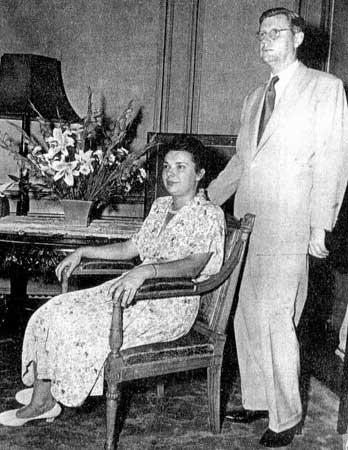
With his wife, Irene. Canadian Mission, Dominnion Day, 1947 in Tokyo
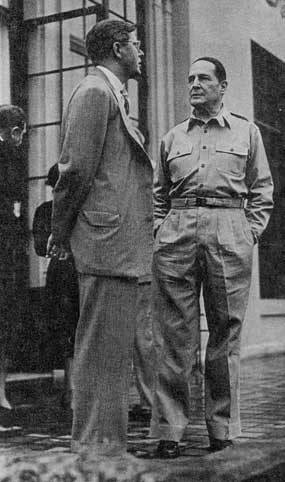
With Douglas MacAthur. Canadian Mission, Dominion Day, 1947 in Tokyo
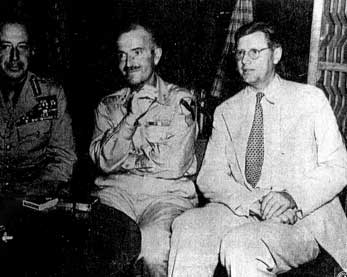
With General H.D.G. Crerar (left) and General Chase (center) at Camp Drake,
Japan, 4 August 1947
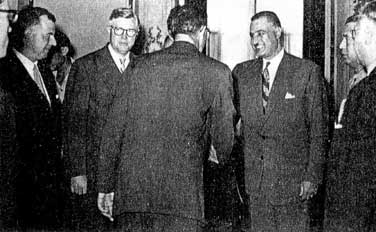
Presenting his staff to Egyptian President Nasser, September 1956
=>Viva! Art Action Top
=>Back to ARAI web
ARAI Shin-ichi (web master/shinichiarai@hotmail.com)










